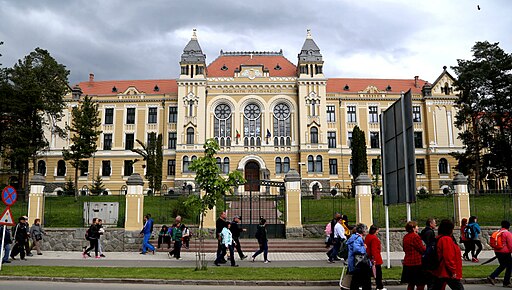Former Roman Catholic Grammar School, Márton Áron and Segítő Mária Roman Catholic High Schools

History
The school was built between 1909 and 1911 in the Art Nouveau style. The former Roman Catholic High School has borne the name of its famous pupil, Bishop Márton Áron, since 1990.
The predecessor of the present school was the Roman Catholic Grammar School of Csíksomlyó, founded by Franciscan monks in the mid-17th century. More recently, researchers have dated the beginnings of school education in Csíksomlyó to the end of the 16th century, based on circumstantial evidence, but there are written documents from the first half of the 17th century, from 1626, about the reorganisation of the school. The grammar school operated in Csíksomlyo until 1911.
In 1900, at a meeting chaired by Count Majláth Gusztáv Károly, Bishop of Transylvania, it was decided to move the grammar school to Csíkszereda. The architect Alpár Ignác was commissioned to prepare the first design and budget for the new building. The final plans were prepared by Pápai Sándor, technical adviser and engineer. The foundation stone was laid in 1909. The construction was financed mainly by state and county subsidies and the price of the former school building in Csíksomlyó. On 5 June 1911, Count Majláth Gusztáv Károly, Bishop of Transylvania, consecrated the new, modern building of the high school.
Two wings were built symmetrically to the grammar school, the right (south) wing housing the seminary and the left wing the dormitory. Between 1914 and 1916, part of the building was requisitioned and converted into a military hospital, and teaching was suspended during the 1916-1917 school year.
After the First World War, the elementary school moved into the building, as well as the teacher training school between 1923-31 and 1941-42.
The school was nationalised in 1948. The first measure was the dismantling of the school chapel and its conversion into a ceremonial hall. The chapel's three giant stained glass windows - depicting King St Stephen of Hungary, his son St Imre and Virgin Mary (patron saint of Hungary) - were removed. The marble plaques in the entrance hall and at the entrance to the dormitory, on which the names of the builders and the date of construction were engraved, were removed, together with the bust of Roman Catholic Bishop Majláth Gusztáv Károly. The school's famous library was sorted out and the books and journals were either locked up or destroyed. The school's associations, the Congregation of Mary and the scout troop were banned. From the 1960-1961 school year onwards, the school started to offer a Romanian-language section.
The building of the former Catholic grammar school is now home to two educational institutions: the state-run secondary school of Csíkszereda, the Márton Áron High School. On 25 May 1990, the school's naming ceremony took place, the most important Hungarian-language secondary school in Csíkszereda taking the name of its former student, Bishop Márton Áron.
Since 1991, the building has been home to the Roman Catholic High School of Mary Help of Christians, which took over the name of the Catholic grammar school from 1940-44.
In 2008, the new stained glass windows of the high school chapel were completed. The artists Nagy Ödön and Vorzsák Gyula created the new stained glass windows. The central stained glass window above the main entrance of the Márton Áron High School depicts Mary with Jesus in her arms. To the right is the figure of St Stephen of Hungary offering his crown to Mary, while the left window shows St Imre, the lily prince.
On 31 May 1997, a bust of the eponymous Bishop Márton Áron (1896-1980) was unveiled in front of the high school. On 24 June 1999, a bust of Count Majláth Gusztáv Károly, Bishop of Transylvania (1864-1940), the builder and benefactor of the school, was unveiled. Both statues are the work of Bodó Levente, a sculptor from Szentegyháza.
In the school foyer, ten marble plaques commemorate the memory of former teachers and students. On 25 May 1990, on the occasion of the naming ceremony, a plaque was unveiled in memory of Bishops Márton Áron and Majláth Gusztáv Károly, Gábor Áron (1814-1849), a hero and cannon founder of 1848, and Kájoni János (1629-1687), a Franciscan monk and polymath.
